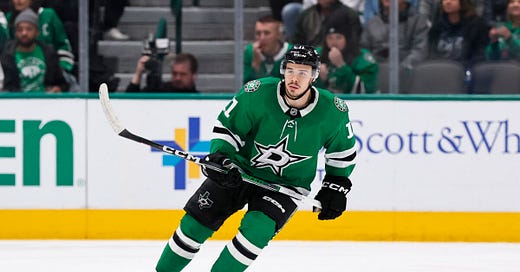How Early Can You Tell If a Player Will be an NHL Star?
What point totals should we look for at each stage of an NHL forward's career?
The best forwards in the NHL come from all sorts of backgrounds. From North America to Europe, they all have a different story to tell. But is their production all that different? When can we tell a player might be the next big thing? We have plenty of analysis on that and more in the following piece.
How the NHL’s Top Stars Progress
It’s common to hear that we can’t be certain of a prospect until they play in the NHL for an extended period of time. While that might be true to some extent, the top stars in the league tend to progress in a similar manner depending on the quality of the player. I’ll specifically look at points in my analysis.
While points aren’t the perfect metric, they do a good job of telling where a player is in their development. If they’re among the top scorers in their league, chances are that they’re ready for the next level—even if they’re a two-way forward. Also, it’s not rare for the best draft “steals” to have scored a lot of points but been undervalued for one reason or another (that’s something we’ll get into).
I compiled the numbers of 40 forwards based on NHL Network’s top 20 centers and top 20 wingers entering the 2024-25 season, looking at their production in terms of points per game (P/G) from their younger years. I looked at their percentile in P/G among other forwards with at least 10 games played in their specific league, starting when they’re 16 or 17 and ending when they’re about 24.
For these players, they are represented across eight different seasons. That being the year before draft eligibility (D-1), their first year of draft eligibility (DY), and their first year after being draft eligible (D+1) up to the player’s sixth year after being draft eligible (D+6).
For the graphic below, I included players who spent their teenage years in amateur leagues, such as the Ontario Hockey League (OHL), ranking their P/G percentiles over the course of eight seasons. It’s important to separate these numbers from a higher-end league with professionals, otherwise the percentiles are less accurate.
Since most players in this set spent their D-1 to D+1 campaigns in their amateur leagues and transitioned to the NHL in their D+2, that’s how I’m showing this data. All 40 players are included in the D+2 numbers and beyond, just for further context:

So, we consistently see these players score atop their league, whether it be the OHL or the NHL. The quick transition to high-end scoring in the NHL isn’t prevalent with everyone, but a lot of players show their worth very quickly.
There are outliers at both ends of the spectrum, but the NHL’s top stars tend to score better than 82 out of every 100 forwards in their amateur league at just 16 and 17 years old, or in their D-1 campaign. Amateur leagues don’t consist of players much older than this, but the age gap is enough to make the 83rd percentile in P/G very impressive.
Not all of your stars are sensational in their D-1, but most are in their DY. With an average percentile of 94th (and a median of between 97th and 98th), these athletes tend to be too good for the league they are in. With an average percentile of 96th in D+1 seasons, that’s when they start gravitating toward the NHL.
For the NHL, it’s a gradual but noticeable rise. It’s important to recognize that not all progression is linear, but stars who see regression almost always bounce back right away. Take Robert Thomas of the St. Louis Blues for example, who went from the 76th percentile in his D+3 to the 44th percentile in his D+4 in terms of NHL P/G—he rose to the 94th percentile in his D+5 and has been one of the league’s best playmakers ever since.
Keep reading with a 7-day free trial
Subscribe to The Hockey Writers - NHL News, Rumors & Opinion to keep reading this post and get 7 days of free access to the full post archives.


